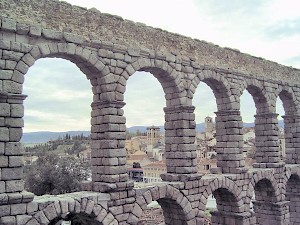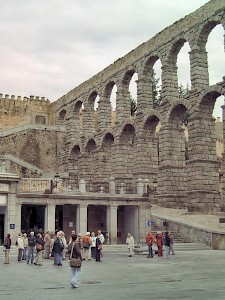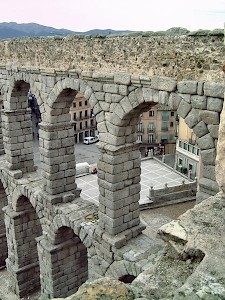Segovia
Q15684Segovia: Roman city in Spain, famous for its aqueduct.

Segovia is a Celtic name; it probably means something like "fortress". The town in Central Spain, which commands the confluence of the rivers Eresma and Clamores, was occupied by an Iberian tribe, the Arevaci. According to Frontinus (Stratagems, 4.5.22), it played a role during the war between the Romans and the Lusitanians, commanded by Viriathus (147-139 BCE).

The city also played a role in the war between the Roman Senate and the rebel general Sertorius (c.76 BCE; Livy, fr.22; to be placed in Book 91). When Pompey the Great had restored order, the area became more tranquil, although it was only during the reign of the emperor Augustus that the Iberian provinces were developed. Segovia became part of Hispania Tarraconensis (conventus of Clunia), situated on the new road between Caesaraugusta (Zaragoza) and Emerita Augusta (Mérida). Archaeologists have identified several buildings, frescoes, and inscriptions. The most famous monument, however, is the 17 km long aqueduct, which was probably built by the emperor Trajan (r.98-117).
Most Roman aqueducts were, at least for a greater part, underground, but sometimes a part had to be constructed across a valley. This meant that a bridge had to be made, and this is the part that dominates modern-day Segovia.
It is almost thirty meters high. In the central pier (on this photo), a small niche can be discerned. Since the sixteenth century, there's a statue of the Blessed Virgin and Saint-Stephen, but there used to be an ancient statue. In the niche on the other side once stood a statue of the demigod Hercules, who was very popular in the Spanish provinces.

The aqueduct was kept intact by later rulers (Visigoths and Moors) until 1072. In that year, thirty-six arches were destroyed as a measure in the wars between the Moors and the Castilians. This part was restored four hundred years later, at the end of the fifteenth century. Ever since, the aqueduct has carried waters from the Fuenfría spring to the town.
A similar monument is the French Pont du Gard, which once brought water from a source near Ucetia (modern Uzès) to Nemausus (Nîmes), 49 km away.